2013 Peugeot 3008 Hybrid 4 warning
[x] Cancel search: warningPage 24 of 340
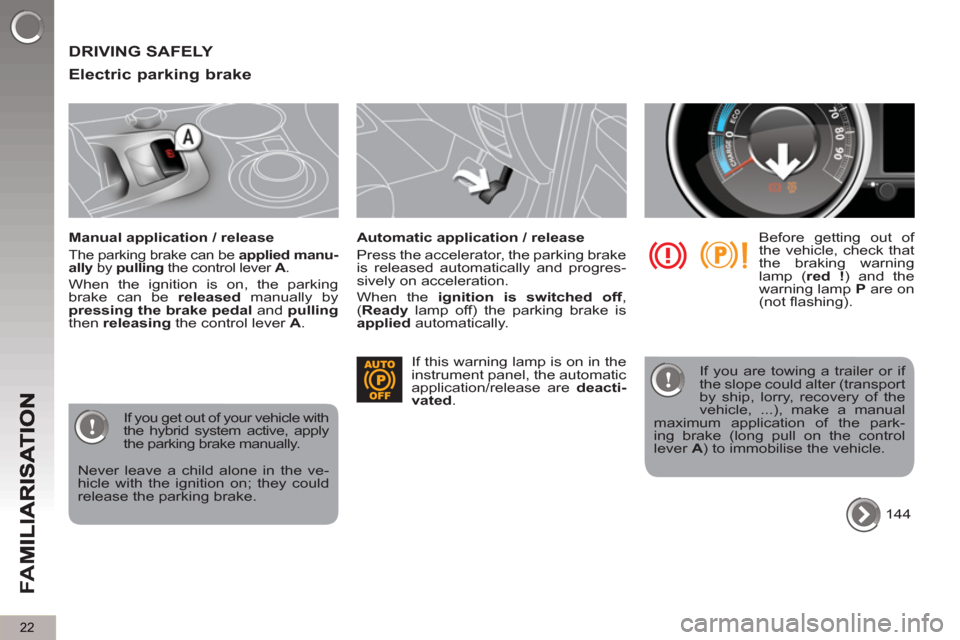
22
FA
M
DRIVING SAFELY
Electric parkin
g brake
Manual application / release
The parking brake can be applied manu-
ally
by pulling
the control lever A
.
When the ignition is on, the parking
brake can be released
manually by
pressing the brake pedal
and pulling
then releasing
the control lever A
.
Automatic application / release
Press the accelerator, the parking brake
is released automatically and progres-
sively on acceleration.
When the ignition is switched off
,
( Ready
lamp off) the parking brake is
applied
automatically.
If you get out of your vehicle with
the hybrid system active, apply
the parking brake manually.
Before getting out of
the vehicle, check that
the braking warning
lamp ( red !
) and the
warning lamp P
are on
(not fl ashing).
Never leave a child alone in the ve-
hicle with the ignition on; they could
release the parking brake.
144 If this warning lamp is on in the
instrument panel, the automatic
application/release are deacti-
vated
.
If you are towing a trailer or if
the slope could alter (transport
by ship, lorry, recovery of the
vehicle, ...), make a manual
maximum application of the park-
ing brake (long pull on the control
lever A
) to immobilise the vehicle.
Page 31 of 340
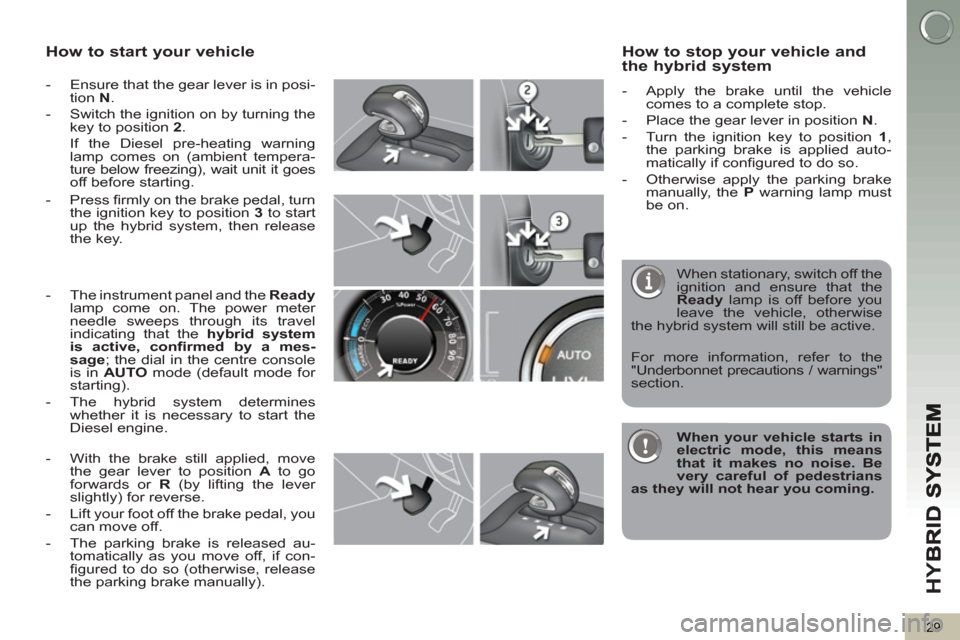
HY
B
29
How to start your vehicle
- Ensure that the gear lever is in posi-
tion N
.
- Switch the ignition on by turning the
key to position 2
.
If the Diesel pre-heating warning
lamp comes on (ambient tempera-
ture below freezing), wait unit it goes
off before starting.
- Press fi rmly on the brake pedal, turn
the ignition key to position 3
to start
up the hybrid system, then release
the key.
- The instrument panel and the Ready
lamp come on. The power meter
needle sweeps through its travel
indicating that the hybrid system
is active, confi rmed by a mes-
sage
; the dial in the centre console
is in AUTO
mode (default mode for
starting).
- The hybrid system determines
whether it is necessary to start the
Diesel engine.
- With the brake still applied, move
the gear lever to position A
to go
forwards or R
(by lifting the lever
slightly) for reverse.
- Lift your foot off the brake pedal, you
can move off.
- The parking brake is released au-
tomatically as you move off, if con-
fi gured to do so (otherwise, release
the parking brake manually).
How to stop your vehicle andthe hybrid system
- Apply the brake until the vehicle
comes to a complete stop.
- Place the gear lever in position N
.
- Turn the ignition key to position 1
,
the parking brake is applied auto-
matically if confi gured to do so.
- Otherwise apply the parking brake
manually, the P
warning lamp must
be on.
For more information, refer to the
"Underbonnet precautions / warnings"
section.
When stationary, switch off the
ignition and ensure that the
Ready
lamp is off before you
leave the vehicle, otherwise
the hybrid system will still be active.
When your vehicle starts in
electric mode, this means
that it makes no noise. Be
very careful of pedestrians
as they will not hear you coming.
Page 32 of 340

HY
B
30
With the gear selector in position N
,
press the brake pedal and start the hy-
brid system.
This lamp comes on when the vehicle is
ready to move off ("Auto" mode is on by
default) and so the driver can press the
accelerator.
This lamp comes on more or less in-
stantly but may take a few seconds
in some cases (in particular, the time
needed for pre-heating the Diesel en-
gine in cold weather or in energy econo-
my mode, for example, ...).
READY LAMP
When stationary, switch off the
hybrid system and check that
the Ready
lamp is off when
you leave the vehicle, other-
wise the hybrid system will remain
active.
For more information, refer to the
"Underbonnet precautions / warnings"
section.
Page 34 of 340
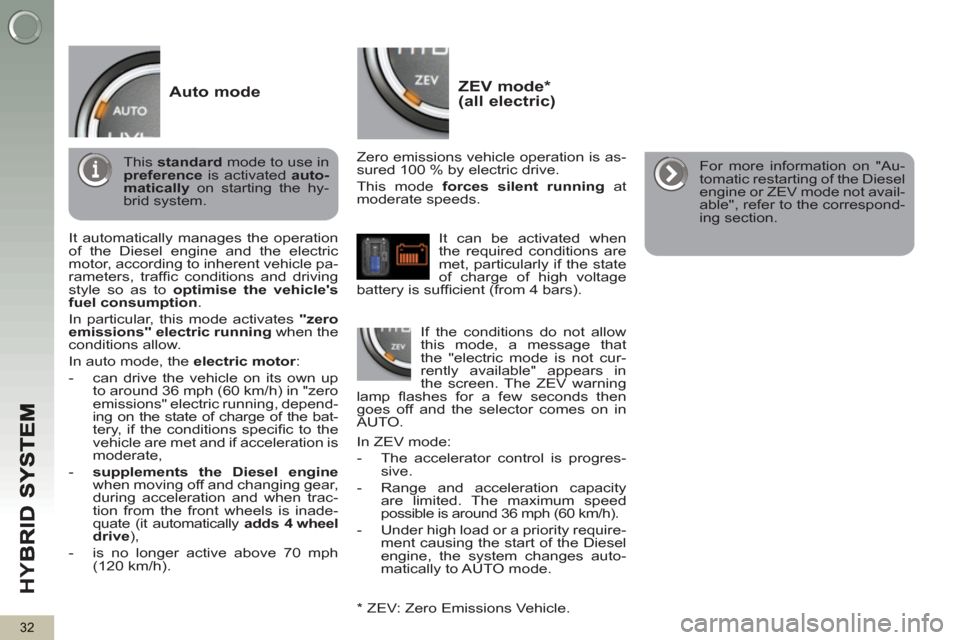
HY
B
32
ZEV mode * (all electric)
Zero emissions vehicle operation is as-
sured 100 % by electric drive.
This mode forces silent running
at
moderate speeds.
* ZEV: Zero Emissions Vehicle. In ZEV mode:
- The accelerator control is progres-
sive.
- Range and acceleration capacity
are limited. The maximum speed
possible is around 36 mph (60 km/h).
- Under high load or a priority require-
ment causing the start of the Diesel
engine, the system changes auto-
matically to AUTO mode.
It can be activated when
the required conditions are
met, particularly if the state
of charge of high voltage
battery is suffi cient (from 4 bars).
If the conditions do not allow
this mode, a message that
the "electric mode is not cur-
rently available" appears in
the screen. The ZEV warning
lamp fl ashes for a few seconds then
goes off and the selector comes on in
AUTO.
Auto mode
It automatically manages the operation
of the Diesel engine and the electric
motor, according to inherent vehicle pa-
rameters, traffi c conditions and driving
style so as to optimise the vehicle's
fuel consumption
.
In particular, this mode activates "zero
emissions" electric running
when the
conditions allow.
In auto mode, the electric motor
:
- can drive the vehicle on its own up
to around 36 mph (60 km/h) in "zero
emissions" electric running, depend-
ing on the state of charge of the bat-
tery, if the conditions specifi c to the
vehicle are met and if acceleration is
moderate,
- supplements the Diesel engine
when moving off and changing gear,
during acceleration and when trac-
tion from the front wheels is inade-
quate (it automatically adds
4 wheel
drive
),
- is no longer active above 70 mph
(120 km/h).
This standard
mode to use in
preference
is activated auto-
matically
on starting the hy-
brid system.
For more information on "Au-
tomatic restarting of the Diesel
engine or ZEV mode not avail-
able", refer to the correspond-
ing section.
Page 45 of 340

HY
B
43
This system does not work continuous-
ly, but adapts the force of the fan cool-
ing to the requirements of the battery.
Its operation can be heard at the rear,
even if the vehicle is stopped after a
run.
If the air intake is blocked, the battery
may overheat, damaging the battery
and causing a loss of performance of
the hybrid system.
FAN COOLING OF THE HIGHVOLTAGE BATTERY
For the best use of the high
voltage battery, please follow
these recommendations:
- do not obstruct the air intake with
loose articles, otherwise, the bat-
tery may overheat, causing a
loss of performance of the hybrid
system
- do not spill fl uids, as this may
cause damage to the battery.
The high voltage battery has an air
cooling system, comprising an air in-
take located under the left hand rear
seat and a fan behind the left hand boot
trim panel.
High voltage
The voltage used for the operation of
the electric motor is in the range 150 to
270 Volts.
Be sure to take account of the warning
labels fi tted to the vehicle.
Take great care regarding the high volt-
age and high temperatures of compo-
nents carrying the current.
Before doing any
work on the vehicle,
switch off the ignition
( Ready
lamp off).
High voltage cables are routed under
the vehicle (sills); take care not to dam-
age them when the vehicle is used for
off-road activity (such as covering rough
ground).
Never touch, dismantle, remove or re-
place the high voltage parts, orange
cables or connectors, even in the event
of an accident.
High voltage cables
Take care to position lifting
equipment (jack, hoist, ...) at
the locations provided to avoid
damaging the cables.
Page 46 of 340
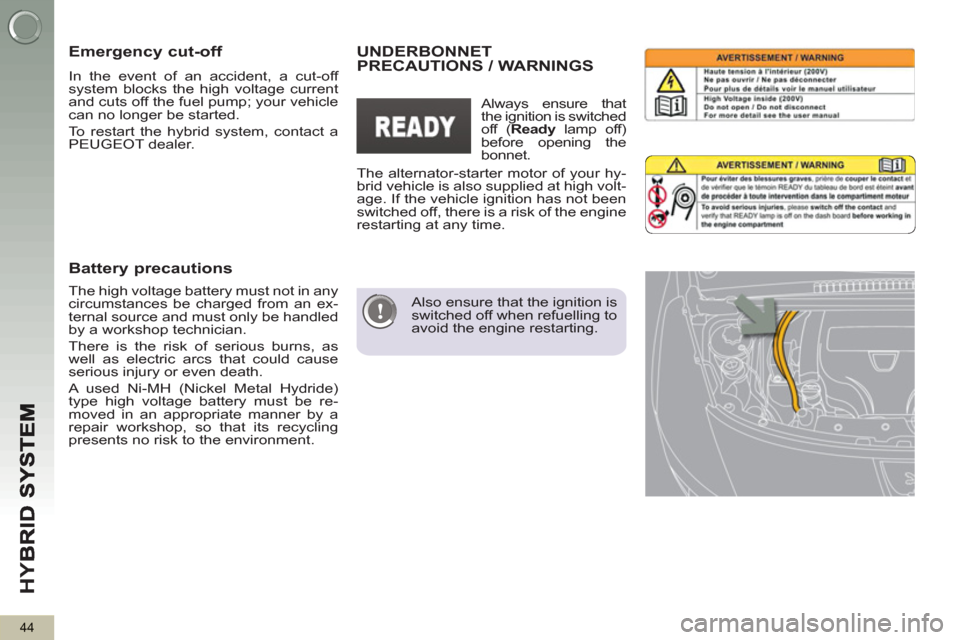
HY
B
44
Also ensure that the ignition is
switched off when refuelling to
avoid the engine restarting.
UNDERBONNETPRECAUTIONS / WARNINGS
The alternator-starter motor of your hy-
brid vehicle is also supplied at high volt-
age. If the vehicle ignition has not been
switched off, there is a risk of the engine
restarting at any time.
Always ensure that
the ignition is switched
off ( Ready
lamp off)
before opening the
bonnet.
The high voltage battery must not in any
circumstances be charged from an ex-
ternal source and must only be handled
by a workshop technician.
There is the risk of serious burns, as
well as electric arcs that could cause
serious injury or even death.
A used Ni-MH (Nickel Metal Hydride)
type high voltage battery must be re-
moved in an appropriate manner by a
repair workshop, so that its recycling
presents no risk to the environment.
Emergency cut-off
Battery precautions
In the event of an accident, a cut-off
system blocks the high voltage current
and cuts off the fuel pump; your vehicle
can no longer be started.
To restart the hybrid system, contact a
PEUGEOT dealer.
Page 49 of 340
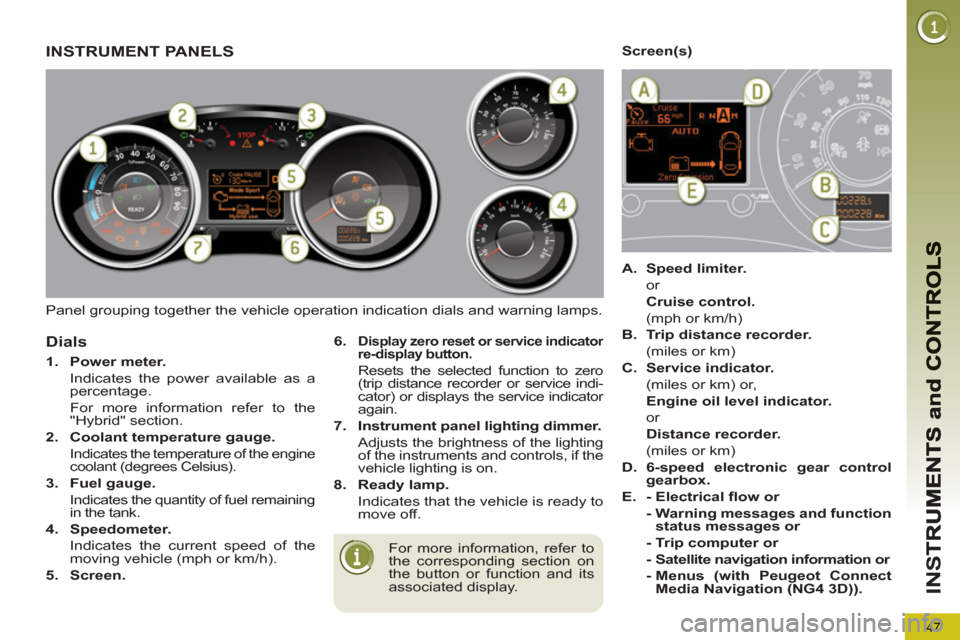
47
IN
S
Panel grouping together the vehicle operation indication dials and warning lamps.
INSTRUMENT PANELS
For more information, refer to
the corresponding section on
the button or function and its
associated display.
Dials
6.
Display zero reset or service indicator
re-display button.
Resets the selected function to zero
(trip distance recorder or service indi-
cator) or displays the service indicator
again.
7.
Instrument panel lighting dimmer.
Adjusts the brightness of the lighting
of the instruments and controls, if the
vehicle lighting is on.
8.
Ready lamp.
Indicates that the vehicle is ready to
move off.
1.
Power meter.
Indicates the power available as a
percentage .
For more information refer to the
"Hybrid" section.
2.
Coolant temperature gauge.
Indicates the temperature of the engine
coolant (degrees Celsius).
3.
Fuel gauge.
Indicates the quantity of fuel remaining
in the tank.
4.
Speedometer.
Indicates the current speed of the
moving vehicle (mph or km/h).
5.
Screen.
Screen(s)
A.
Speed limiter.
or
Cruise control.
(mph or km/h)
B.
Trip distance recorder.
(miles or km)
C.
Service indicator.
(miles or km) or,
Engine oil level indicator.
or
Distance recorder.
(miles or km)
D.
6-speed electronic gear control
gearbox.
E.
- Electrical fl ow or
- Warning messages and function
status messages
or
- Trip computer or
- Satellite navigation information or
-
Menus (with Peugeot Connect
Media Navigation (NG4 3D)).
Page 51 of 340
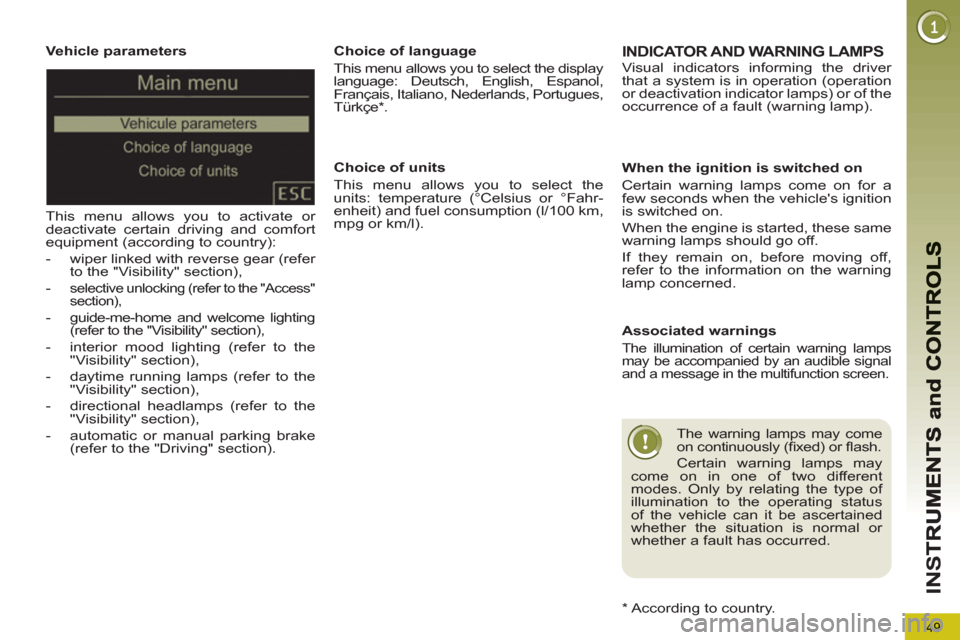
49
IN
S
Vehicle parameters
This menu allows you to activate or
deactivate certain driving and comfort
equipment (according to country):
- wiper linked with reverse gear (refer
to the "Visibility" section),
-
selective unlocking (refer to the "Access"
section),
- guide-me-home and welcome lighting
(refer to the "Visibility" section),
- interior mood lighting (refer to the
"Visibility" section),
- daytime running lamps (refer to the
"Visibility" section),
- directional headlamps (refer to the
"Visibility" section),
- automatic or manual parking brake
(refer to the "Driving" section).
Choice of units
This menu allows you to select the
units: temperature (°Celsius or °Fahr-
enheit) and fuel consumption (l/100 km,
mpg or km/l).
Choice of language
This menu allows you to select the display
language: Deutsch, English, Espanol,
Français, Italiano, Nederlands, Portugues,
Türkçe * .
*
According to country.
INDICATOR AND WARNING LAMPS
When the ignition is switched on
Certain warning lamps come on for a
few seconds when the vehicle's ignition
is switched on.
When the engine is started, these same
warning lamps should go off.
If they remain on, before moving off,
refer to the information on the warning
lamp concerned.
Associated warnings
The illumination of certain warning lamps
may be accompanied by an audible signal
and a message in the multifunction screen.
The warning lamps may come
on continuously (fi xed) or fl ash.
Certain warning lamps may
come on in one of two different
modes. Only by relating the type of
illumination to the operating status
of the vehicle can it be ascertained
whether the situation is normal or
whether a fault has occurred.
Visual indicators informing the driver
that a system is in operation (operation
or deactivation indicator lamps) or of the
occurrence of a fault (warning lamp).